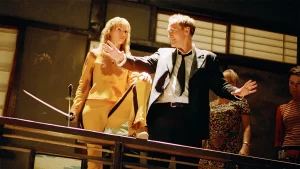Kill Bill: Vol. 2: Tarantino’s Climactic Revenge Tale Turns 20
Quentin Tarantino is a director who takes his time. With the nine films he has directed, he crafts them with unmatched precision, which has earned him awards and respect from his peers. By the mid-2000s, Tarantino had to move off the world of witty dialogue-driven crime dramas that put him on the map in the 1990s.
Reservoir Dogs, Pulp Fiction, and Jackie Brown all defined an era, but eras change, culture shifts, and what movie lovers want is something they don’t know until it smacks them right in the face. Enter Kill Bill: Vol. 1, Tarantino’s attempt at stepping away from hitmen in suits to a revenge tale that was so carefully pieced together it was done in two parts, so less than a year after its release came Kill Bill: Vol. 2, now 20 years old today.
Released in 2004, Kill Bill: Vol. 2 slows its roll a bit from the sword-swinging blood fest that took up almost an hour of screen time in its predecessor and shows us the kind of storyteller Tarantino would become as his career would continue after the film. He would pace his films slower, but he would bait you and pull you along for a lengthy ride that pays off big time when the movie cuts to black and his name appears in the “Written & Directed by…” screen credit.
Kill Bill: Vol. 2 was made for thirty million dollars and grossed around one hundred and fifty-two million during its release. The only sequel Tarantino has ever made (that we know of) switches genres a bit from its predecessor. Vol. 1 is Tarantino’s homage to Hong Kong action movies that he sings praises for time and time again. Adding cast members like Sonny Chiba and Gordon Liu to show off how serious Tarantino was.

The prequel also homages Lady Snowblood from Bruce Lee’s Game of Death with Uma Thurman’s wardrobe in the final fight scene. One thing it also does is tease us about Bill, the man who plotted the death of Thurman’s Beatrix Kiddo and failed. Bill is presented like the famous Bond villain Blofield. We see his feet, hear his calm voice, and he drops a cliffhanger of information to pull us into Vol. 2.
When we get to Vol. 2, we learn that Tarantino went against the grain with the film’s title character and Big Bad. David Carradine, in a role like this, is genius. Bill seems like he has no sense of ill will when we meet him. It is almost like the role is an extended version of the monk character he played on the show that made him famous, Kung Fu. It’s here that the genre switches.
Tarantino makes us study both Bill and the Bride and their motivations towards the actions of one another. By this point in his career, Kill Bill: Vol. 2 could be argued to be the best script Tarantino has ever written, as he investigates the trauma of his protagonist on a deeper level. There is no big surprise as to who Bill is or what he looks like; he just shows up. There is also no big drama in Beatrix and Bill’s showdown.
Because for ninety minutes between the beginning and that part, we got a lot of backstory that led us to see these two face-to-face. That’s the genius of Tarantino; you think he’s going to give you a crazy shootout, and he actually gives you two people in a room talking, but only one is walking out alive.
The sequel does not have a superficial way of telling its story; it’s all in the analogies. An example is Bill’s story of Superman and Clark Kent and how Clark Kent is a disguise for how Superman views the human race, and in the end, he’s Superman. This meant Bill could never let Beatrix go and live a normal life, so he did what he had to do at her wedding.
Bill is arguably one of Tarantino’s best characters, despite his screen time being so limited. Carradine should have gotten an Oscar for the film’s last twenty minutes alone. As much as we try to sympathize with him, we know the mask is falling off as he shows slight outbursts of anger towards Beatrix.
In the end, Tarantino again shows us a big payoff for how his protagonist overpowers her adversary. It’s a subtle judge of character that came from both Bill and Beatrix’s trainer, Pai Mei (played by Gordon Liu). Pai Mei never taught Bill the Five Point Palm Exploding Heart Technique, but he taught it to Beatrix because he knew she had a heart and deserved better.
He also knew that Bill was ruthless and evil, despite his charming manner. The technique is used on Bill and pays off better than any sort of sword fight fans of the series may have initially wanted.
The character of The Bride was created back when Quentin Tarantino and Uma Thurman were making Pulp Fiction a decade earlier. The film hits a point in his career when he had to be highly ambitious. The action is all in Vol. 1 but the information you need for a hell of a payoff is in the now 20-year-old Vol. 2.
Tarantino weaves clues as to where this series is going all over the script. Vol. 1 is supposed to jar you and excite you; its sequel is meant to have you sit in silence and listen. When you think of how much Tarantino uses great character development, it’s a trait that really hits a stride smack dab in the middle of his career, twenty years ago with Kill Bill: Vol. 2.
What do you think of the Kill Bill series? Which is your favourite one? Let us know in the comments below.
